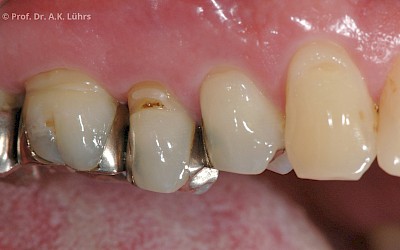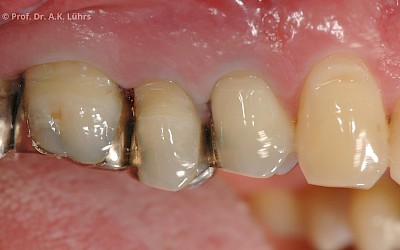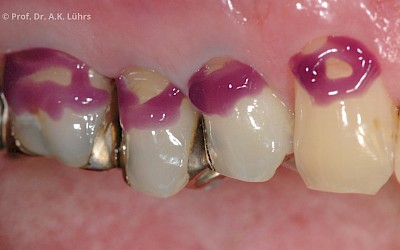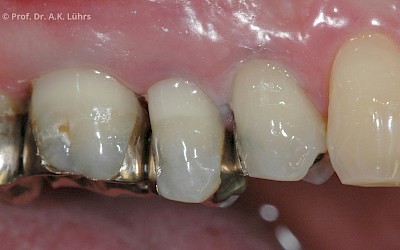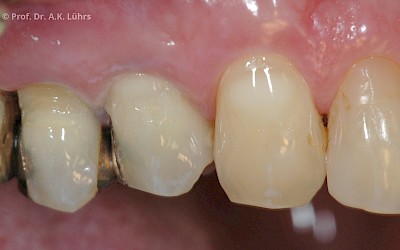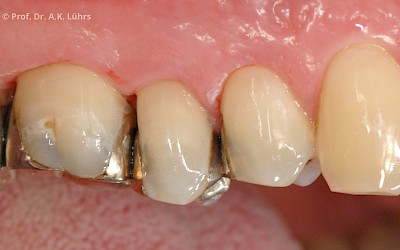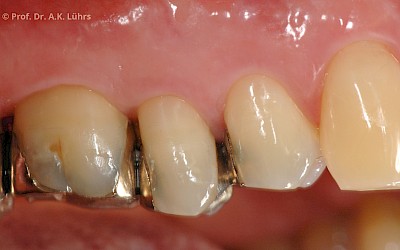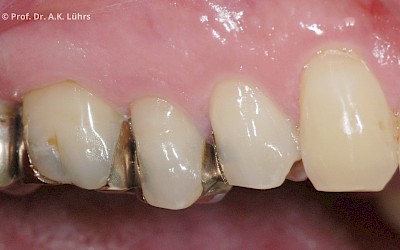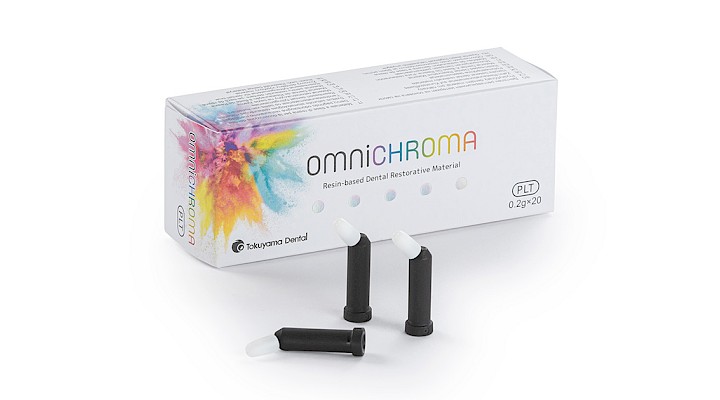
Restoration of tooth neck defects by means of a universal composite with shade-matching properties
Introduction
Tooth neck defects are a common phenomenon that can occur in all age groups (Penoni et al. 2021). Influencing factors such as gender, age, tooth brushing behaviour, acid consumption in the context of nutrition as well as the number of remaining natural teeth are important modulating factors (Penoni et al. 2021). In the 15-39 age group, the risk of non-carious cervical lesions (NCCL) increases by a factor of 2.29 with acid intake (Penoni et al. 2021). Furthermore, the use of hard toothbrushes promotes the development of NCCLs (Sadaf & Ahmad 2014). Overall, the weighted prevalence of NCCLs was reported to be 46.7% in a systematic review, and it was higher in the age group 30 years and older than in those under 30 years (53 vs. 43%, Teixeira et al. 2020).
If there is an indication for restoring such a defect, composite materials can be used in compliance with the rules of adhesive technique. The success rate of such restorations varies significantly depending on the study. When comparing the use of the etch & rinse technique with the self-etch technique, a retention rate of 92.9 and 88.9%, respectively, was observed after 6 years, with no difference between the two groups (Peumans et al. 2021). The same working group was able to measure retention rates of 89.7% after 9 years of intraoral retention in another study (Peumans et al. 2018). In addition to complete loss of retention, fractures and discolouration also lead to failure of composite restorations in NCCLs (Peumans et al. 2018 and 2021). In 2019, the material OMNICHROMA (TOKUYAMA DENTAL, Tokyo, Japan) was introduced to the dental market (Eliezer et al. 2020). According to the manufacturer, this material is characterised by the fact that it should be possible to match the shade of almost any existing tooth shade with only one material (literature). This concept certainly offers advantages for the practice, for example, fewer shades have to be bought „in stock“. Furthermore, the point „tooth shade determination“ is omitted in the course of treatment, which can certainly be technique- sensitive, since even short drying phases can change the light transmission of the enamel (Brodbelt et al. 1982). The following case illustrates the restoration of cervical defects with OMNICHROMA material after a follow-up period of 32 months.
Case presentation: Restoration of cervical defects on teeth 13-16
In the present patient case, there were cervical defects on teeth 13-16 that required treatment.
Teeth 15 and 16 had previously been restored with composite restorations, but partial loss had occurred over time (Fig. 1). Restorative therapy for the defects was carried out in July 2018. After placing retraction threads (Ultrapak, Ultradent Products GmbH, Cologne) to displace the gingiva on teeth 14-16, the remaining restorative material on teeth 15/16 was removed and secondary preparation was carried out on the teeth in question. No retraction cord had to be placed on tooth 13 because it was a supragingival, enamel-limited defect. This was followed by selective enamel conditioning using phosphoric acid gel (Gel Etchant, Kerr GmbH, Biberach) and the application of a universal adhesive (Scotchbond Universal, 3M Deutschland GmbH, Neuss).
The restorations were fabricated using a universal composite which, according to the manufacturer, has colour-matching properties (OMNICHROMA, TOKUYAMA DENTAL, Tokyo, Japan); it was not necessary to select a colour due to the material-related colour matching (Fig. 4/5). Figure 4 shows the composite in cavities 13/14 before polymerisation. In figure 5, the composite has already been polymerised on teeth 13/14 and only applied on teeth 15/16. Clearly visible before polymerisation is opaque-white colour, which adapts to the tooth structure after polymerisation and gains translucency. The restorations after polishing are shown in figure 6. Further checks were carried out at 6-month intervals (figure 7). Figure 8 shows the restorations after 32 months, i.e. after more than 2.5 years of intraoral retention. The colour match of the restorations with the adjacent tooth structure is still very good, but the indirect restorations on teeth 14-16 are now scheduled for replacement due to insufficient margins with secondary caries.
Discussion
The case illustration shows the restoration of four Class V defects with a follow-up period of 32 months. The intraoral shade stability and shade match in this case can be rated as very good. The composite “OMNICHROMA” used in this case has colour-matching properties that are achieved by spherical fillers (diameter 260 nm) embedded in a translucent matrix. This special material composition allows incoming light to completely penetrate the restoration and is then reflected by the cavity wall and scattered by the fillers, adding red and yellow components to the light reflected in tooth colour (OMNICHROMA Technical Report, TOKUYAMA), resulting in the described colour matching properties. Various studies have already been studies have already been published.
When comparing the shade match of denture teeth in the shade spectrum A1-A3 in prepared Class III cavities, significant differences in the shade match between “classical” composites in Vita shades and the composite with shade-matching properties were found (de Abreu et al. 2021). Another in vitro study on posterior teeth demonstrated that OMNICHROMA showed a better shade match in lighter shades than in darker shades (C2, D3, Iyer et al. 2021). In another study, a strong dependence of the evaluation of the shade matching properties on the size of the restoration was found: for complete layering of a posterior tooth, OMNICHROMA showed the highest shade discrepancies, and for Class I cavities, the visually evaluated shade matching was the best (Pereira Sanchez et al. 2019).
Furthermore, there is a dependence on the cavity depth, the colour matching in 3 mm deep cavities was significantly better than in 2 mm deep cavities (Akgül et al. 2022). OMNICHROMA showed colour stability after artificial ageing in a study (Sensi et al. 2021), which was also confirmed in the presented patient case after an intraoral retention time of the restorations of 32 months (compare Fig. 8).
In summary, OMNICHROMA represents an interesting alternative for the practice for small to medium-sized cavities. In large cavities, especially class III and IV, the shade match may be somewhat compromised; if necessary, the use of OMNICHROMA BLOCKER (TOKUYAMA DENTAL, Tokyo, Japan) can remedy this. The advantage of the material is certainly to simplify existing protocols such as shade taking, which is highly dependent on the practitioner, and subsequently to layer a restoration with only one material.
Literature list upon request.

Author:
Professor Dr Anne-Katrin Lührs
Senior Physician at the Department of Conservative Dentistry, Periodontology and Preventive Dentistry, Hannover Medical School (Director: Professor Dr Nadine Schlüter)
Carl-Neuberg-Str. 1
DE-30625 Hannover
Germany
Phone: +49 511 5324815
https://www.mhh.de/kliniken-der-mhh/klinik-fuer-zahnerhaltung-parodontologie-und-praeventivzahnmedizin
